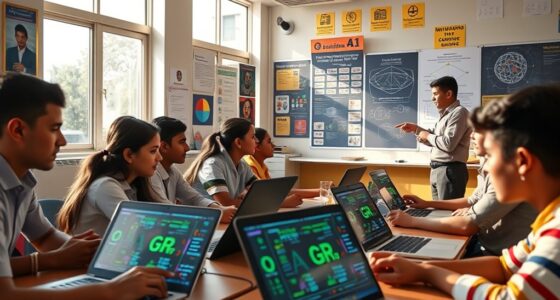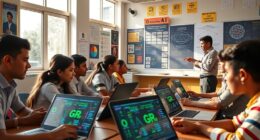As we delve into the realm of education, we uncover the transformative power of personalized learning. Tailored to address the unique requirements of each student, this approach ignites a love for learning and motivates them to reach their goals.
By providing individualized instruction for diverse learners, we empower every student to thrive. Through this lens, we witness the enhancement of critical thinking and problem-solving skills, as well as the cultivation of student ownership in their own learning journey.
With customized pacing and flexible learning paths, the doors to liberation swing wide open.
Key Takeaways
- Personalized learning promotes autonomy and ownership over education.
- Flexible learning paths enable students to choose effective routes to achieve their goals.
- Customization in learning tailors education to individual needs and addresses specific learning challenges.
- Empowering students through personalized learning builds self-confidence, encourages active participation, and develops critical thinking and problem-solving skills.
Improved Student Engagement and Motivation
To achieve improved student engagement and motivation, we must start with a genuine understanding of their individual needs and interests.

Active learning strategies and gamification in the classroom have emerged as powerful tools to enhance student engagement and motivation.
Active learning strategies involve students in the learning process through hands-on activities, group discussions, and problem-solving tasks. This approach fosters critical thinking, collaboration, and creativity, creating a dynamic and interactive learning environment.
On the other hand, gamification in the classroom employs game-like elements to make learning more enjoyable and engaging. By introducing elements such as rewards, levels, and challenges, gamification taps into students’ natural inclination for competition and achievement.
Research has shown that both active learning strategies and gamification significantly improve student motivation, leading to enhanced engagement, higher academic performance, and a deeper understanding of the subject matter.

Individualized Instruction for Diverse Learners
As we delve into the subtopic of individualized instruction for diverse learners, we continue to explore the transformative power of personalized learning. Differentiated assessments and adaptability in the curriculum are key components of this approach. By tailoring assessments to individual student needs, educators can gain a deeper understanding of each learner’s strengths and areas for improvement. This allows for targeted instruction and support, ensuring that every student has the opportunity to succeed. Furthermore, an adaptable curriculum ensures that students can engage with content in a way that is meaningful and relevant to their unique interests and learning styles. This flexibility not only promotes greater engagement and motivation but also fosters a sense of ownership and agency in the learning process. Through personalized learning, we can create an educational system that celebrates and supports the diverse needs and abilities of all learners.
| Differentiated Assessments | Adaptability in Curriculum |
|---|---|
| Tailors assessments to individual student needs | Promotes meaningful and relevant learning experiences |
| Identifies strengths and areas for improvement | Fosters engagement, motivation, and ownership |
| Provides targeted instruction and support | Celebrates and supports diverse learners |
Enhanced Critical Thinking and Problem-Solving Skills
We continue our exploration into the transformative power of personalized learning by focusing on how it enhances our critical thinking and problem-solving skills.
Personalized learning encourages enhanced creativity, allowing individuals to think outside the box and come up with innovative solutions to complex problems. It also promotes improved decision-making, as learners are empowered to make choices based on their own interests and strengths.
Through personalized learning, students are encouraged to analyze information critically, evaluate different perspectives, and make informed judgments. This approach helps develop their ability to solve problems independently and collaboratively, equipping them with essential skills for success in the 21st century.

Increased Student Ownership of Learning
Student ownership of learning is a fundamental aspect of personalized education. It empowers students to take control of their educational journey and actively engage in their own growth and development. This concept emphasizes student autonomy and self-directed learning, allowing students to have a say in their educational experiences.
Research has shown that when students have ownership over their learning, they are more motivated, engaged, and invested in their education. They become active participants in the learning process, setting goals, making choices, and taking responsibility for their own progress.
This level of ownership not only fosters a sense of empowerment but also enhances critical thinking and problem-solving skills. By encouraging student ownership, personalized learning creates an environment that promotes liberation and allows students to thrive as independent learners.
Customized Pacing and Flexible Learning Paths
One key aspect of personalized learning is the ability to customize the pace of our learning and have flexible learning paths. This approach recognizes that each individual learns at their own unique speed and has different preferences for how they acquire knowledge.

By allowing learners to set their own pace, personalized learning promotes a sense of autonomy and ownership over their education.
Additionally, flexible learning paths enable students to choose the most effective and engaging route to achieve their learning goals. This can be facilitated through the use of adaptive assessments, which provide personalized feedback and adjust the difficulty level based on the learner’s performance.
Such customization and flexibility in learning paths empower students to take control of their education and maximize their learning potential.
Frequently Asked Questions
How Can Personalized Learning Improve Collaboration and Teamwork Among Students?
Improving collaboration and fostering teamwork among students, personalized learning allows for individualized instruction, promoting active engagement and cooperative learning. By tailoring instruction to students’ unique needs and interests, they are more likely to work together effectively and contribute to a collaborative learning environment.

What Strategies Can Be Used to Ensure Equal Access to Personalized Learning for Students With Disabilities?
Equal access to personalized learning for students with disabilities can be ensured through inclusive strategies. By providing accommodations, assistive technologies, and individualized support, we can empower all students to thrive and reach their full potential.
How Does Personalized Learning Support the Development of Creativity and Innovation in Students?
Personalized learning fosters student autonomy and curiosity, enabling the development of creativity and innovation. By tailoring instruction to individual needs and interests, students are empowered to think critically, problem-solve, and explore their own unique ideas.
Can Personalized Learning Help Students Develop Effective Communication Skills?
Yes, personalized learning can help students develop effective communication skills. By tailoring instruction to individual needs, students can practice and receive feedback on their communication skills, leading to improved proficiency and confidence.
What Role Does Technology Play in Facilitating Personalized Learning and How Can It Be Effectively Integrated Into the Classroom?
Technology integration plays a crucial role in facilitating personalized learning and enhancing student engagement. By effectively integrating technology into the classroom, students can access personalized content, collaborate with peers, and receive immediate feedback, leading to a more meaningful and effective learning experience.

Conclusion
In conclusion, personalized learning has the potential to revolutionize education by unlocking the full potential of every student.
Like a key fitting perfectly into a lock, personalized learning aligns with each student’s unique needs and abilities, igniting a passion for learning that can propel them forward.
By embracing this approach, we can foster a generation of engaged, motivated learners who are equipped with the critical thinking and problem-solving skills necessary for success in an ever-evolving world.











